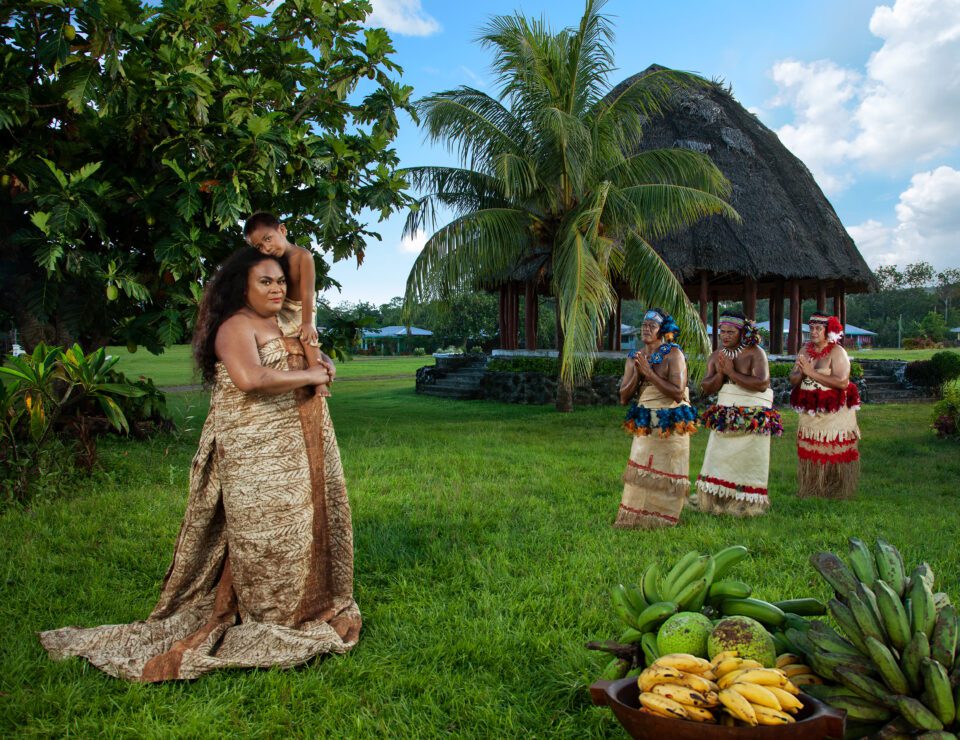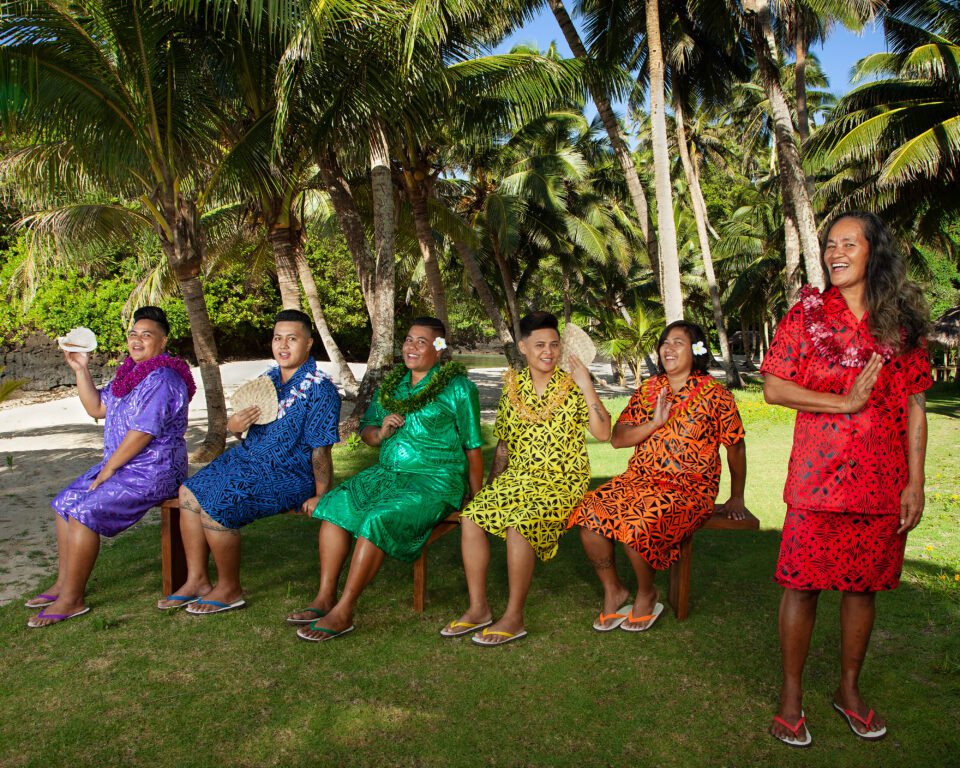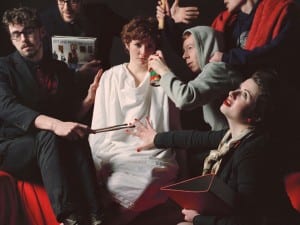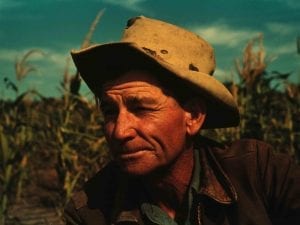The UN Human Rights Office estimates that 5% of Samoa’s population identify as Fa’afafine. The island country, which lies between New Zealand and Hawaii, recognises four cultural genders: female, male, fa’afafine and fa’afatama. The terms fa’afafine and fa’afatama translate to “in the manner of a woman” and “in the manner of a man” respectively, and are used by non-binary people across Samoa, American Samoa and the Samoan diaspora. “Western society tries to fit [us] in a box, to put us under gay, under trans and queer … but I think fa’afafine is our cultural identity, it defines us,” residents told Reuters. Samoan-Japanese artist Yuki Kihara (b. 1975), who identifies as Fa’afafine, draws on these social structures through bold photography of people and place, challenging gendered stereotypes. “The idea of paradise that’s fed to us is so heteronormative,” Kihara told the Financial Times, “I wanted to challenge that by deploying the camp aesthetic.”

Paradise Camp received global acclaim at the 2022 Venice Biennale, becoming the first show in the event’s history to feature work by a Pasifika and Fa’afafine artist. It now travels to Powerhouse Ultimo for its Australian premiere. “Camp,” defined by American essayist Susan Sontag (b. 1933), “is a mode of seduction,” engaging in artifice and stylisation by revelling in the multiplicity of gender. The word provided the theme for the 2019 New York Met Gala and continues to inspire television, pop culture and politics. Donald Trump’s 2020 re-election campaign, for example, has been deemed “Total Camp” by The Atlantic for its use of masculine archetypes and carnivalesque rallies, causing satire and comedy. In the exhibition, Kihara plays with campness through 12 tableau photographs and a five-part “talk show” series, with Fa’afafine commenting on canonical paintings as well as the artist’s personal archive. As curator Natalie King notes in Financial Times: “Yuki’s rigour on the research side is compelling,” melding the flamboyant and factual.
In the photographer’s After Gauguin series, Paul Gauguin’s (1848-1903) Post-Impressionist paintings are repurposed and upcycled into saturated portraits. The artist travelled to Tahiti and Marquesas between 1891 and 1903 to depict life on the island. In La Orana Maria (Hail Mary) (1891), a yellow angel points out Mary and Jesus to two Tahitian women amidst a dense background of flowering trees and dark mountains. Kihara revisits this composition in Si’ou alofa Maria: Hail Mary (After Gauguin), repurposing the narrative to highlight the latent eroticism and misogyny in the earlier painting, whilst also providing a platform for the modern-day experiences of the Fa’afafine community. In the contemporary rendition, Mary is replaced with activist Vaito’a Toelupe, who is dressed in a long traditional robe. A group of Fa’afafine watch on, hands clasped together as they nod toward the saintly figure and her child. In the background, gloomy foliage is swapped for a thatched fale house – the former residence of Paramount Chief of Samoa Mata’afa Iosefo, who played a vital role in resisting colonial forces during the 19th century.

Elsewhere, in Three Fa’afafine, a group of figures bearing fruit and flowers look over their shoulders towards the camera. Here, the artist is uncompromisingly exact in her recreation of detail, positioning models as they appear in Gauguin’s Three Tahitians (1899) with red dresses, white shawls and flower-braided hair. Furthermore, the figure in the middle of the scene references an image taken by New Zealand photographer Thomas Andrew (b. 1855) that informed Gauguin, depicting a Samoan man with a tradition pe’a tattoo on his back. With this reference, Kihara challenges the western art canon, reclaiming pictures once used for colonial documentation. Staged subjects are unapologetic and resolute, confronting the lens in moments of joy, playfulness and longing.
In these reimagined compositions, the myth of the “Pacific Paradise” becomes destabilised. As Kihara explains to Time Out, Samoa is associated with “newly married couples holding hands … walking alongside the beach. And then there’s one of us natives waiting in the corner ready to serve cocktails.” These commercial depictions are reflected in the extensive archive of vintage travel posters and pamphlets included in Paradise Camp, appealing to western sentiments of tiki bars and romantic getaways. In response, the artist shifts from the perspective of the singular to the communal, collaborating with traditional landowners and over 100 Samoans. In Nafea e te fa’aipopo? When will you marry (After Gauguin), two women rest on a bed of rocks next to a pool, hands hovering over their bodies. The image strays from the warm palettes and dusty sunsets of western holiday brochures, instead forming a portrait that is stark, forceful and unanimous.

Collaboration is also central to the artist’s film, First Impressions: Paul Gauguin (2018), where interviews with Fa’afafine addressing the colonial gaze are combined with footage of local workshops on the climate crisis. Almost 80% of the Samoan population reside in coastal areas, with sea levels rising up to four millimetres a year in the country – occurring five times faster than the global average. Kihara’s work, populated by waterfalls, coastlines and verdant forests, does not simply comply to a tourist aesthetic, but draws attention to a precarious and changing landscape, encouraging action in order to find shared solutions. Paradise Camp is emblematic of the joy and resilience of Samoans. The exhibition at Powerhouse Ultimo is powerful in its ability to demonstrate the issues faced by the fa’afafine population, both socially and environmentally. In this Pasifika-specific utopia, power and honesty exist in shared experiences and actions of collectives.
Paradise Camp
Powerhouse Ultimo | Until December
Words: Chloe Elliott
Credits:
1. Nafea e te fa‘aipoipo? When will you marry? (After Gauguin), 2020 by Yuki Kihara from Paradise Camp series. Courtesy of Yuki Kihara and Milford Galleries, Aotearoa New Zealand.
2. Si‘ou alofa Maria: Hail Mary (After Gauguin), 2020 by Yuki Kihara from Paradise Camp series. Courtesy of Yuki Kihara and Milford Galleries, Aotearoa New Zealand.
3. Three Fa’afafine (After Gauguin), 2020 by Yuki Kihara from Paradise Camp series. Courtesy of Yuki Kihara and Milford Galleries, Aotearoa New Zealand.
4. Genesis 9:16 (After Gauguin), 2020 by Yuki Kihara from Paradise Camp series. Courtesy of Yuki Kihara and Milford Galleries, Aotearoa New Zealand.





